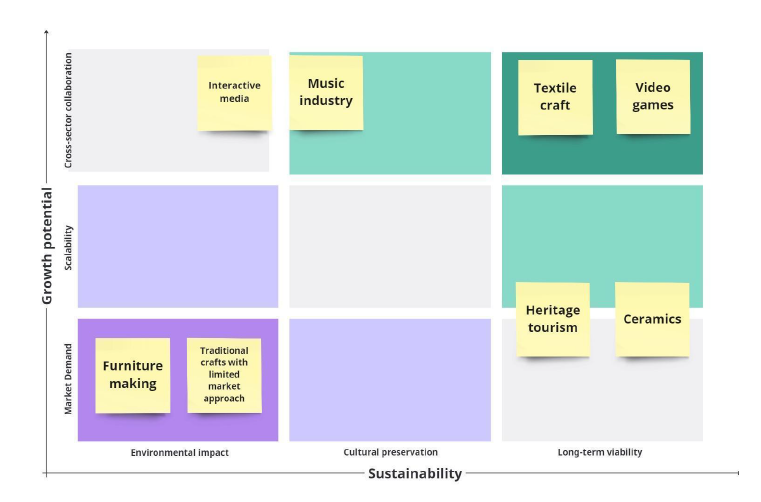Access to culture in the regions is one of the key pillars of the “Cultural Compass”, the European Commission's ambitious strategic initiative for the cultural and creative sectors. The IN SITU research project focused on six different non-urban European regions and examined the potential for the development of specific sub-sectors of the cultural and creative industries. The results were encouraging.
The sub-sectors of textiles, ceramics, furniture making, museums, video games and music appear to have significant potential for innovation and growth. According to IN SITU's assessment, these key subsectors can not only be drivers of local socio-economic development, but can also play a critical role in preserving cultural heritage and promoting sustainable practices. However, their success depends on a combination of innovation, community engagement and supportive public policies.
Specific regional insights from the analysis include Azores (Portugal), West Region (Iceland), Western Coastal Periphery (Ireland), West Coast and Baltic Sea Archipelago (Finland), Valmiera County (Latvia), Šibenik-Knin County (Croatia).
In recent years, cultural and creative industries (CCIs) have been recognised as key drivers of socio-economic development across Europe. Traditionally, CCIs have been strongly associated with urban environments, where infrastructure, resources and dense networks of cultural actors provide fertile ground for innovation and economic growth. However, there is growing recognition of the potential of CCIs to act as catalysts for change and resilience in non-urban areas, where they contribute to the preservation of cultural heritage, local identity and community cohesion.
Non-urban areas appear to present both opportunities and challenges for cultural and creative industries. Rural and peripheral regions often have rich cultural assets and traditions that have been nurtured over centuries and offer unique value in today's experience-driven and identity-centred economy. However, as the six case studies also show, these regions often lack the infrastructural and institutional support needed for CCIs to thrive, including access to finance, digital connectivity and market reach. In addition, rural cultural policies are often designed by and for urban centres, resulting in an approach that does not fully take into account the specific needs and capacities of non-urban CCIs. As a result, the growth and impact of CCIs in these areas remains underdeveloped, despite their potential to contribute significantly to social innovation, sustainable development and community well-being.
The report examines how cultural and creative industries in non-urban areas can use their unique characteristics to drive innovation and development in their communities. It focuses on sustainable business practices, participatory processes and digitalisation strategies that can extend the reach and impact of cultural and creative industries to wider audiences, including younger generations who increasingly engage with culture through digital platforms.
According to the report's findings, the textile crafts subsector has strong growth potential, especially as global demand for sustainable, handmade products continues to rise. In regions such as Valmiera County, Latvia, and Šibenik-Knin County, Croatia, textile artisans are successfully combining traditional techniques with modern design, attracting international buyers who value authenticity and eco-conscious products. The shift towards sustainable fashion further enhances the long-term viability of this sector, with opportunities for expansion through e-commerce and international certification schemes.
Similarly, ceramics is a promising sub-sector with deep cultural roots. Artisans in regions such as the West Coast and Baltic Archipelago in Finland and the Western Coastal Periphery in Ireland are capitalising on the growing demand for sustainable household goods and artistic ceramics. However, the challenge of scaling up production remains a limiting factor. Investment in shared production spaces and artisan cooperatives could help overcome these barriers, enabling potters to meet higher demand while maintaining the integrity of their craft.
The furniture manufacturing subsector offers significant opportunities, particularly in the area of custom-made, eco-friendly furniture. By tapping into the global trend for bespoke, sustainable home furnishings, artisans in regions such as the Western Coastal Periphery, Ireland, and Valmiera County, Latvia, are well positioned to expand. Digital platforms or dedicated artisan marketplaces offer a crucial avenue for growth, allowing furniture makers to reach a wider audience while maintaining the personal nature of their work.
In the cultural sector, museums and heritage tourism play a crucial role in both preserving local culture and attracting tourists. By integrating digital tools such as virtual tours and augmented reality experiences, museums in regions such as Šibenik-Knin County, Croatia, and the Azores, Portugal, are extending their reach beyond physical borders. These digital innovations offer museums and heritage sites a sustainable way forward by engaging new, tech-savvy audiences while preserving cultural knowledge for future generations.
Finally, the video games and music sub-sectors have shown strong growth potential, especially as digital platforms facilitate global distribution. The video games industry, particularly in the West Coast and Baltic Archipelago, Finland, and the Western Coastal Periphery, Ireland, has shown promise in fusing local narratives with interactive media, creating a global market for regionally inspired games. Meanwhile, musicians in the Azores, Portugal, and West Region, Iceland, have embraced digital streaming platforms to gain international exposure. However, both sub-sectors face sustainability challenges, including the environmental impact of large-scale production and performance tours. Further investment in sustainable practices and financial support will be crucial for their long-term development.
According to the IN SITU researchers, in order to fully realise the potential of these key CCI subsectors, public policies and funding programmes need to be tailored to the specific needs of non-urban regions. Their recommendations for public policies and funding programmes include the need to develop tailored public policies for non-urban CCIs, improve access to digital platforms, increase access to public and private funding, promote community engagement through collaborative initiatives, and encourage youth engagement through technology and innovation.
You can read the whole report here
--
Photo credit: Diego Delso
Copyright: CC-BY-SA 4.0
Photo source









